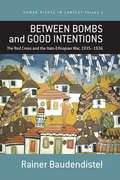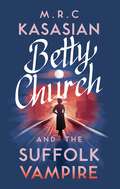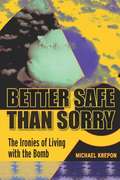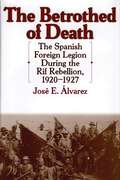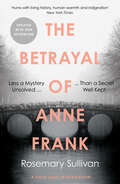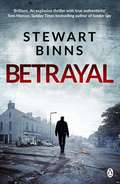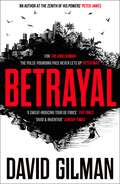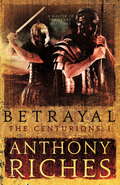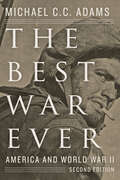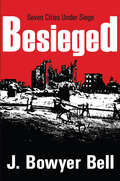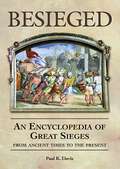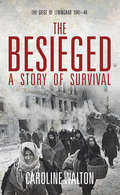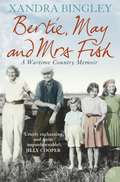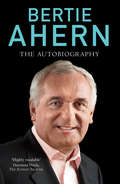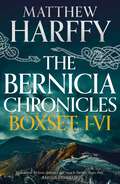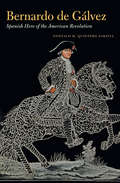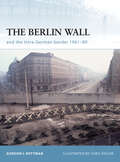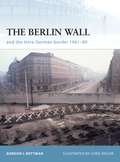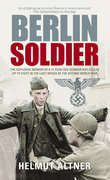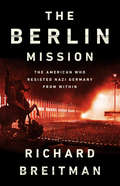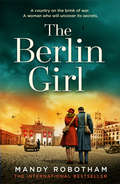- Table View
- List View
Between Bombs and Good Intentions: The International Committee of the Red Cross (ICRC) and the Italo-Ethiopian war, 1935-1936 (Human Rights in Context #1)
by Rainer BaudendistelThe wars in Afghanistan and Iraq have highlighted again the precarious situation aid agencies find themselves in, caught as they are between the firing lines of the hostile parties, as they are trying to alleviate the plight of the civilian populations. This book offers an illuminating case study from a previous conflict, the Italo-Ethiopian war of 1935-36, and of the humanitarian operation of the Red Cross during this period. Based on fresh material from Red Cross and Italian military archives, the author examines highly controversial subjects such as the Italian bombings of Red Cross field hospitals, the treatment of Prisoners of War by the two belligerents; and the effects of Fascist Italy’s massive use of poison gas against the Ethiopians. He shows how Mussolini and his ruthless regime, throughout the seven-month war, manipulated the International Committee of the Red Cross (ICRC) – the lead organization of the Red Cross in times of war, helped by the surprising political naïveté of its board. During this war the ICRC redefined its role in a debate, which is fascinating not least because of its relevance to current events, about the nature of humanitarian action. The organization decided to concern itself exclusively with matters falling under the Geneva Conventions and to give priority to bringing relief over expressing protest. It was a decision that should have far-reaching consequences, particularly for the period of World War II and the fate of Jews in Nazi concentration camps.
Betty Church and the Suffolk Vampire
by M.R.C. KasasianA man is murdered in broad daylight by a stealthy killer in this pitch-perfect WWII crime mystery. September 1939. Inspector Betty Church – one of the few female officers on the force – has arrived from London to fill a vacancy at Sackwater police station. But Betty isn't new here. This is the place she grew up. The place she thought she'd left for good. After a slow start, Betty's called to the train station to investigate a stolen bench. But though there's no bench, there is a body. A smartly dressed man, murdered in broad daylight, with two distinctive puncture wounds in his throat. While the locals gossip about the Suffolk Vampire, Betty Church steels herself to hunt a dangerous killer. Reviews for BETTY CHURCH AND THE SUFFOLK VAMPIRE: 'Betty Church is a wonderful creation... Had me laughing out loud' GOODREADS. 'I loved this... A cast of crazy characters, with a gruesome murder or two thrown in for good measure' GOODREADS. 'Loved Betty Church! No nonsense, in control with quirky crazy cast makes this a new series I can't wait to read more of' GOODREADS.
Better Safe Than Sorry: The Ironies of Living with the Bomb
by Michael KreponIn 2008, the iconic doomsday clock of the Bulletin of the Atomic Scientistswas set at five minutes to midnight—two minutes closer to Armageddon than in 1962, when John F. Kennedy and Nikita Khrushchev went eyeball to eyeball over missiles in Cuba! We still live in an echo chamber of fear, after eight years in which the Bush administration and its harshest critics reinforced each other's worst fears about the Bomb. And yet, there have been no mushroom clouds or acts of nuclear terrorism since the Soviet Union dissolved, let alone since 9/11. Our worst fears still could be realized at any time, but Michael Krepon argues that the United States has never possessed more tools and capacity to reduce nuclear dangers than it does today - from containment and deterrence to diplomacy, military strength, and arms control. The bloated nuclear arsenals of the Cold War years have been greatly reduced, nuclear weapon testing has almost ended, and all but eight countries have pledged not to acquire the Bomb. Major powers have less use for the Bomb than at any time in the past. Thus, despite wars, crises, and Murphy's Law, the dark shadows cast by nuclear weapons can continue to recede. Krepon believes that positive trends can continue, even in the face of the twin threats of nuclear terrorism and proliferation that have been exacerbated by the Bush administration's pursuit of a war of choice in Iraq based on false assumptions. Krepon advocates a "back to basics" approach to reducing nuclear dangers, reversing the Bush administration's denigration of diplomacy, deterrence, containment, and arms control. As he sees it, "The United States has stumbled before, but America has also made it through hard times and rebounded. With wisdom, persistence, and luck, another dark passage can be successfully navigated."
The Betrothed of Death: The Spanish Foreign Legion During the Rif Rebellion, 1920-1927 (Contributions in Comparative Colonial Studies)
by José E. AlvarezFollowing her defeat in the Spanish-American War of 1898, Spain shifted her colonial focus to her Protectorate in northern Morocco. When Spanish conscripts began to fight and to die by the thousands, political fallout forced the government to create a new unit of professional soldiers. This unit would serve the dual function of providing fighting men for Moroccan service, while sparing the lives of conscripted men. Under its founder, José Millán Astray, and his deputy, Francisco Franco, the Spanish Foreign Legion would quickly become the spearhead for Spain's army in Africa. This is the story of the creation, organization, and combat role of the Legion in its formative years from 1919 to 1927.Based upon archival sources in Madrid, Segovia, and Ceuta, this is the first and most complete history in English or Spanish of the early years of the Spanish Foreign Legion. The unit was instrumental in crushing Abd-el-Krim's rebellion against Spanish colonial authority. When the Riffians annihilated the army of General Silvestre at Annual in 1921 and were poised to attack the Spanish enclave of Melilla, it was the arrival of the Legion that pacified its panic-stricken citizens. The force would be in the vanguard of all major offensives undertaken in recapturing the territory lost in 1921, and its amphibious landing at Alhucemas Bay in 1925 marked the beginning of the end for the Rif Rebellion.
The Betrayal of Anne Frank: A Cold Case Investigation
by Rosemary Sullivan‘Hums with living history, human warmth and indignation’ New York Times Less a mystery unsolved than a secret well kept The mystery has haunted generations since the Second World War: Who betrayed Anne Frank and her family? And why?
Betrayal
by Stewart Binns'Brilliant. An explosive thriller with true authenticity' Tom Marcus, bestselling author of Soldier Spy----------------- January, 1981. They're undercover in Belfast.Determined to put an end to a war.But in doing so, who will they betray? Jim Dowd and Maureen O'Brien, special forces soldiers, enter a bitterly divided Belfast with a mission: to go undercover, infiltrate one of the city's most dangerous Catholic neighbourhoods, and help change the course of a war that nobody is winning. The Ardoyne is a perilous world, where even a hint of their true identities will prove fatal. But it is also full of courage and loyalty, and Jim realises he admires this community - and his guilt at their deception grows ever stronger. When they receive shocking orders, Maureen knows they must act swiftly and ruthlessly, but can she rely on Jim? And if they rebel, are they betraying their country; or are they being betrayed? 'Stunningly realistic . . . A must-read for anyone who cares about the history of our islands' Nick Hewer
Betrayal (The Englishman #2)
by David GilmanDan Raglan, former Foreign Legion fighter, alias The Englishman, returns. The new high-octane international thriller from David Gilman.Someone's trying to start a war. And Raglan's just walked into the kill zone.It has been many years since Dan Raglan served in the French Foreign Legion, but the bonds forged in adversity are unbreakable and when one of his comrades calls for help, Raglan is duty-bound to answer.An ex-legionnaire, now an intelligence officer at the Pentagon, disappears. He leaves only this message: should he ever go missing, contact Raglan. But Raglan's not the only one looking for the missing man. From the backstreets of Marseilles, Raglan finds himself following a trail of death that will lead him to Florida, to a Vietnam vet in Washington D.C., and into the heart of a bitter battle in the upper echelons of the US intelligence community.Pursued by both the CIA and a rogue female FBI agent, Raglan's search will place him in the cross hairs of an altogether more lethal organisation. He finds himself in the midst of deadly conspiracy, and on a journey to a fatal confrontation deep in the Honduran rainforest.Reviewers on Betrayal:'Well plotted, believable, and Gilman's ace at bringing locations to life.' The Sun 'Hard to put down.' Daily Express 'A masterfully crafted thriller that grips from the first page to the explosive last.' Sunday Express 'The hero is a veritable one-man army – think Lee Child's Jack Reacher, except English – combining a lethal resilience with a fiery determination to see justice served.' Newslanes 'A vividly intense spy thriller overflowing with courage, resourceful smarts, and a whole host of furious combative encounters.' LoveReadingReviewers on The Englishman series:'A sweat-inducing tour de force.' The Times 'An author at the zenith of his powers.' Peter James 'Raglan is nicely complex: an action man with inner depths.' Financial Times 'Full of thrills.' Literary Review 'The pulse-pounding pace just never lets up.' Peter May
Betrayal: The Centurions I (The Centurions)
by Anthony RichesAD 69: The Rhine frontier has exploded into bloody rebellion, and four centurions who once fought in the same army find themselves on opposite sides of a vicious insurrection.The rebel leader Kivilaz and his Batavi rebels have humbled the Romans in a battle they should have won. The legions must now defend their northern stronghold, the Old Camp, from the enraged tribes of Germany, knowing that they cannot be relieved until the civil war raging to the south has been resolved. Can they defend the undermanned fortress against thousands of barbarian warriors intoxicated by a charismatic priestess's vision of victory?
The Best War Ever: America and World War II (The American Moment)
by Michael C. AdamsWas World War II really such a "good war"? Popular memory insists that it was, in fact, "the best war ever." After all, we knew who the enemy was, and we understood what we were fighting for. The war was good for the economy. It was liberating for women. A battle of tanks and airplanes, it was a "cleaner" war than World War I. Although we did not seek the conflictâ€�or so we believedâ€�Americans nevertheless rallied in support of the war effort, and the nation’s soldiers, all twelve million of them, were proud to fight. But according to historian Michael C. C. Adams, our memory of the war era as a golden age is distorted. It has left us with a misleadingâ€�even dangerousâ€�legacy, one enhanced by the nostalgia-tinged retrospectives of Stephen E. Ambrose and Tom Brokaw. Disputing many of our common assumptions about the period, Adams argues in The Best War Ever that our celebratory experience of World War II is marred by darker and more sordid realities. In the book, originally published in 1994, Adams challenges stereotypes to present a view of World War II that avoids the simplistic extremes of both glorification and vilification. The Best War Ever charts the complex diplomatic problems of the 1930s and reveals the realities of ground combat: no moral triumph, it was in truth a brutal slog across a blasted landscape. Adams also exposes the myth that the home front was fully united behind the war effort, demonstrating how class, race, gender, and age divisions split Americans. Meanwhile, in Europe and Asia, shell-shocked soldiers grappled with emotional and physical trauma, rigorously enforced segregation, and rampant venereal disease.In preparing this must-read new edition, Adams has consulted some seventy additional sources on topics as varied as the origins of Social Security and a national health system, the Allied strategic bombing campaign, and the relationship of traumatic brain injuries to the adjustment problems of veterans. The revised book also incorporates substantial developments that have occurred in our understanding of the course and character of the war, particularly in terms of the human consequences of fighting. In a new chapter, "The Life Cycle of a Myth," Adams charts image-making about the war from its inception to the present. He contrasts it with modern-day rhetoric surrounding the War on Terror, while analyzing the real-world consequences that result from distorting the past, including the dangerous idea that only through (perpetual) military conflict can we achieve lasting peace.
The Best of Daughters
by Dilly CourtDespite her privileged upbringing, Daisy Lennox has always longed to make something of her life. She is drawn to the suffragette movement, but when her father faces ruin they are forced to move to the country and Daisy’s first duty is to her family.Here she becomes engaged to her childhood friend – a union both families have dreamed of. But, on the eve of their wedding, war is declared, and Daisy knows her life will never be the same again…
Besieged: Seven Cities Under Siege
by J. Bowyer BellJ. Bowyer Bell's Beseiged is built on the premise that as long as men have constructed walls, other men have tried to scale them. From ancient Jericho and Joshua's trumpet to London and the onslaught of the Luftwaffe, people have always devised cunning weapons, with all the skills at their command, to breach such barriers and invade the camps and fortified places of their enemies.Beseiged is the story of seven great modern sieges: Madrid in the Spanish Civil War; London, Warsaw, Singapore and Stalingrad in World War II; Berlin during the Post World War II Airlift; and Jerusalem under Arab attack from four sides in 1947. Bell, a veteran historian, describes in detail the actual battles involved, clearly demonstrating the universality of sieges and siegecraft and showing that all these beleaguered places have things in common and obey certain basic laws or principles.Bell points out commonalities showing, for example, though no bullets were fired during the Berlin Airlift, the city itself was as much under siege as was Warsaw, where the Polish Underground fought a fierce but hopeless battle against Hitler's Wehrmacht. By the same token, Bell shows though no German infantry ever came close to London, it was nonetheless besieged by aerial squadrons just as surely as Stalingrad was by both German and Russian ground forces. The histories of these sieges are ones of heroism and cowardice, meticulous planning and incredible blunders, all of which can be studied and used even currently in similar situations in either defending, or piercing the defenses of, a location in times of unrest or war.Beseiged is a must-read for those interested in modern conflict pondering the enigma of human endeavor in wall building and breaking involved in siegecraft. A must-read for everyone from military strategist aficionados and historians to science and technology buffs. If it is to be believed the danger of not knowing history is the possibility of unknowingly repeating it, then Beseiged should appear on all required reading lists.
Besieged: Seven Cities Under Siege
by J. Bowyer BellJ. Bowyer Bell's Beseiged is built on the premise that as long as men have constructed walls, other men have tried to scale them. From ancient Jericho and Joshua's trumpet to London and the onslaught of the Luftwaffe, people have always devised cunning weapons, with all the skills at their command, to breach such barriers and invade the camps and fortified places of their enemies.Beseiged is the story of seven great modern sieges: Madrid in the Spanish Civil War; London, Warsaw, Singapore and Stalingrad in World War II; Berlin during the Post World War II Airlift; and Jerusalem under Arab attack from four sides in 1947. Bell, a veteran historian, describes in detail the actual battles involved, clearly demonstrating the universality of sieges and siegecraft and showing that all these beleaguered places have things in common and obey certain basic laws or principles.Bell points out commonalities showing, for example, though no bullets were fired during the Berlin Airlift, the city itself was as much under siege as was Warsaw, where the Polish Underground fought a fierce but hopeless battle against Hitler's Wehrmacht. By the same token, Bell shows though no German infantry ever came close to London, it was nonetheless besieged by aerial squadrons just as surely as Stalingrad was by both German and Russian ground forces. The histories of these sieges are ones of heroism and cowardice, meticulous planning and incredible blunders, all of which can be studied and used even currently in similar situations in either defending, or piercing the defenses of, a location in times of unrest or war.Beseiged is a must-read for those interested in modern conflict pondering the enigma of human endeavor in wall building and breaking involved in siegecraft. A must-read for everyone from military strategist aficionados and historians to science and technology buffs. If it is to be believed the danger of not knowing history is the possibility of unknowingly repeating it, then Beseiged should appear on all required reading lists.
Besieged: An Encyclopedia of Great Sieges from Ancient Times to the Present
by Paul K. DavisBesieged examines the most important sieges in history—the actions and motivations of attackers and defenders along with conditions inside and outside the city walls.From Joshua's assault on Jericho in the 15th century B.C. to the Russian attack on the Chechen capital of Grozny at the end of the 20th century, siege warfare has been a recurring theme in the human story. Again and again, engineers have built supposedly impregnable fortifications, only to see them overrun by an ingenious enemy.In Besieged, military historian Paul F. Davis analyzes the most crucial sieges in world history, such as the siege of Leningrad, which weakened the Nazi forces in World War II, and that of the Alamo, which culminated in independence for Texas. He also describes important sieges unfamiliar to most readers, such as that of Arcot, where a British victory halted the French takeover of southern India. In engaging, accessible language, Davis tracks the invention of new technologies, analyzes innovative tactics, and tells the human story of conditions both inside and outside the city walls.
The Besieged: A Story of Survival
by Caroline WaltonThe Besieged is a beautifully observed account of one of the defining moments of twentieth-century history: the Siege of Leningrad. The Siege began in September 1941, when German forces severed the last connection to the city, and was to last for 872 days, during which the dying population suffered horrors almost beyond the powers of description.
Bertie the Blitz Dog
by Libby ParkerTHE PERFECT HEARTWARMING READ for THE NEW YEAR . . . As bombs rain from the skies, can Bertie the Blitz dog find a safe home? Pampered pooch Bertie's owner has passed away. Cold, alone and scared, he's now a stray on London's streets. With a terrible war on, the city is bombed nightly. While rationing has left people starving. It is a dangerous time to have four legs and no owner. So when Bertie meets one special little boy, he thinks he has a chance to find a new home and happiness amidst the rubble. But Bertie - a small dog with the very big heart - knows it'll take all his courage to keep himself and his new friends safe . . . Hopeful, heart-warming and fun, Bertie the Blitz Dog is perfect for fans of Felix the Railway Cat and The Nightingale Christmas Show, Donna Douglas.
Bertie, May and Mrs Fish: Country Memories Of Wartime
by Xandra BingleyA lyrical, evocative and wonderfully original wartime memoir about life on a farm in the Cotswolds, seen through the eyes of a child.
Bertie Ahern Autobiography: The Autobiography
by Bertie AhernBertie Ahern, three times Irish Taoiseach, is often described as an enigma. The Old IRA man's son who delivered peace in Northern Ireland. A working class boy responsible for the Celtic Tiger. The man of faith who ushered in progressive, cosmopolitan secular Ireland. An ardent nationalist admired by European leaders. 'I know 25 per cent of Bertie Ahern', said his finance minister, Charlie McCreevy, 'and that's 24 per cent more than anyone else.'Now in this frank and revealing autobiography, Ahern gives his own account of a remarkable political life and the personal story that accompanies it. He shows the cost to his family of a life played out in the public eye and, for the first time, discloses what really happened in his final weeks in power.Here for the first time is the truth behind the man who is Bertie.Ahern has been at the cutting edge of Irish politics for over three decades. He was first elected to Dáil Éireann in the Fianna Fáil landslide victory in 1977 that saw Jack Lynch returned as Taoiseach. In 1982, Charles Haughey appointed him Government Chief Whip. In volatile political times, he strongly supported Haughey during three challenges to his leadership of Fianna Fáil.In 1987, Bertie Ahern received his first cabinet portfolio as Minister for Labour. It was a time when the Irish economy was in crisis. Ireland had a higher debt per head than Ethiopia or Sudan. Unemployment stood at 16%. Ahern negotiated Ireland's first social partnership agreement, which underpinned economic recovery and put in place the foundations for a period of sustained growth. In 1991, he was appointed Minister for Finance. International commentators first began to refer to 'Ireland's Tiger economy' in this period. When Bertie Ahern left the Department of Finance in late 1994, for the first time in almost 30 years, Ireland had a budget surplus.Bertie Ahern succeeded Albert Reynolds as leader of Fianna Fáil in November 1994. Following the General Election in 1997, he became Ireland's youngest ever Taoiseach. The Ahern Era was a time of unprecedented progress in Irish society. Over the course of his tenure in office, Ireland's economy out-performed that of every other European country. For the first time ever, the number of people in employment in the State reached 2 million.Working closely with Bill Clinton and Tony Blair, Ahern won widespread acclaim for his perseverance and skill in negotiating the Good Friday Agreement, which has provided the political framework for a lasting peace in Northern Ireland.On the international stage, he was a respected figure who enjoyed an acclaimed Presidency of the European Council in 2004. He presided over the completion of the largest ever expansion of the EU and concluded negotiations on a European constitution. He is one of only five visiting statesmen to have addressed both the United States Congress and the Houses of Parliament in Westminster.At home, Ahern enjoyed phenomenal electoral support. He was the first Taoiseach since 1944 to win three successive General Elections.Bertie Ahern resigned on 6th May, 2008. He had served for ten years, ten months and ten days as Taoiseach.
The Bernicia Chronicles Boxset: I-VI (The Bernicia Chronicles)
by Matthew Harffy'Historical fiction doesn't get much better than this.' Angus DonaldWe first encounter doughty warrior Beobrand in The Serpent Sword as he fights for King Edwin in Northumbria, while seeking vengeance for his brother's death. In The Cross and the Curse, Beobrand returns home a hero after a stunning victory against the Waelisc, but despite riches and fame for his skill in battle, he is soon surrounded by enemies and treachery on all sides. Blood and Blade sees Beobrand escorting a princess of Wessex to her new home in Northumbria, as bride of King Oswald. With Oswald away fighting the Picts, and old enemies closing in, it is up to Beobrand to overcome the plots and perils in their path and get his new queen safely home.In Killer of Kings, Beobrand finds himself caught up in bloody conflict as Penda of Mercia marches on the southern kingdoms just as Beobrand is sent on an important mission by his king. Warrior of Woden sees Beobrand, now a renowned warlord, fight for his king, Oswald of Northumbria, as Penda invades the kingdom in a clash of pagans and Christians and a battle for the soul of Albion. Storm of Steel sees Beobrand sail to lands he once knew on a perilous quest to avenge a girl kidnapped by slavers.Collected in a single volume for the first time, books 1–6 of the epic Bernicia Chronicles series featuring mighty Anglo-Saxon warlord Beobrand, including:THE SERPENT SWORD THE CROSS AND CURSE BLOOD AND BLADE KILLER OF KINGS WARRIOR OF WODEN STORM OF STEELReviewers on Matthew Harffy:'Nothing less than superb.' Historical Novel Society 'Beobrand is the warrior to follow.' David Gilman
Bernardo de Gálvez: Spanish Hero of the American Revolution
by Gonzalo M. Quintero SaraviaAlthough Spain was never a formal ally of the United States during the American Revolution, its entry into the war definitively tipped the balance against Britain. Led by Bernardo de Galvez, supreme commander of the Spanish forces in North America, their military campaigns against British settlements on the Mississippi River—and later against Mobile and Pensacola—were crucial in preventing Britain from concentrating all its North American military and naval forces on the fight against George Washington's Continental army. In this first comprehensive biography of Galvez (1746@–86), Gonzalo M. Quintero Saravia assesses the commander's considerable historical impact and expands our understanding of Spain's contribution to the war.A man of both empire and the Enlightenment, as viceroy of New Spain (1785@–86), Galvez was also pivotal in the design and implementation of Spanish colonial reforms, which included the reorganization of Spain's Northern Frontier that brought peace to the region for the duration of the Spanish presence in North America. Extensively researched through Spanish, Mexican, and U.S. archives, Quintero Saravia's portrait of Galvez reveals him as central to the histories of the Revolution and late eighteenth-century America and offers a reinterpretation of the international factors involved in the American War for Independence.
The Berlin Wall and the Intra-German Border 1961-89 (Fortress)
by Gordon L. RottmanThe border between East and West Germany was closed on 26 May 1953. On 13 August 1961 crude fences and walls were erected around West Berlin: the Berlin Wall had been created. The Wall encircled West Berlin for a distance of 155km, and its barriers and surveillance systems evolved over the years into an advanced obstacle network. The Intra-German Border ran from the Baltic Sea to the Czechoslovak border for 1,381km, and was where NATO forces faced the Warsaw Pact for the 45 years of the Cold War. This book examines the international situation that led to the establishment of the Berlin Wall and the IGB, and discusses how these barrier systems were operated, and finally fell.
The Berlin Wall and the Intra-German Border 1961-89 (Fortress)
by Gordon L. Rottman Chris TaylorThe border between East and West Germany was closed on 26 May 1953. On 13 August 1961 crude fences and walls were erected around West Berlin: the Berlin Wall had been created. The Wall encircled West Berlin for a distance of 155km, and its barriers and surveillance systems evolved over the years into an advanced obstacle network. The Intra-German Border ran from the Baltic Sea to the Czechoslovak border for 1,381km, and was where NATO forces faced the Warsaw Pact for the 45 years of the Cold War. This book examines the international situation that led to the establishment of the Berlin Wall and the IGB, and discusses how these barrier systems were operated, and finally fell.
Berlin Soldier: The Explosive Memoir of a 12 Year-old German Boy Called Up to Fight in the Last Weeks of the Second World War
by Helmut AltnerThis book is an explosive memoir of a 17 year old German boy called up to fight in the last weeks of the Second World War. This is a teenager's vivid account of his experiences as a conscript during the final desperate weeks of the Third Reich, during which he experienced training immediately behind the front line east of Berlin, was caught up in the massive Soviet assault on Berlin from the Oder, retreated successfully and then took part in the fight for the western suburb of Spandau, where he became one of the only two survivors of his company of seventeen year-olds.
The Berlin Mission: The American Who Resisted Nazi Germany from Within
by Richard BreitmanAn unknown story of an unlikely hero--the US consul who best analyzed the threat posed by Nazi Germany and predicted the horrors to comeIn 1929, Raymond Geist went to Berlin as a consul and handled visas for emigrants to the US. Just before Hitler came to power, Geist expedited the exit of Albert Einstein. Once the Nazis began to oppress Jews and others, Geist's role became vitally important. It was Geist who extricated Sigmund Freud from Vienna and Geist who understood the scale and urgency of the humanitarian crisis.Even while hiding his own homosexual relationship with a German, Geist fearlessly challenged the Nazi police state whenever it abused Americans in Germany or threatened US interests. He made greater use of a restrictive US immigration quota and secured exit visas for hundreds of unaccompanied children. All the while, he maintained a working relationship with high Nazi officials such as Heinrich Himmler, Reinhard Heydrich, and Hermann Göring.While US ambassadors and consuls general cycled in and out, the indispensable Geist remained in Berlin for a decade. An invaluable analyst and problem solver, he was the first American official to warn explicitly that what lay ahead for Germany's Jews was what would become known as the Holocaust.
The Berlin Mission: The American Who Resisted Nazi Germany from Within
by Richard BreitmanAn unknown story of an unlikely hero--the US consul who best analyzed the threat posed by Nazi Germany and predicted the horrors to comeIn 1929, Raymond Geist went to Berlin as a consul and handled visas for emigrants to the US. Just before Hitler came to power, Geist expedited the exit of Albert Einstein. Once the Nazis began to oppress Jews and others, Geist's role became vitally important. It was Geist who extricated Sigmund Freud from Vienna and Geist who understood the scale and urgency of the humanitarian crisis.Even while hiding his own homosexual relationship with a German, Geist fearlessly challenged the Nazi police state whenever it abused Americans in Germany or threatened US interests. He made greater use of a restrictive US immigration quota and secured exit visas for hundreds of unaccompanied children. All the while, he maintained a working relationship with high Nazi officials such as Heinrich Himmler, Reinhard Heydrich, and Hermann Göring.While US ambassadors and consuls general cycled in and out, the indispensable Geist remained in Berlin for a decade. An invaluable analyst and problem solver, he was the first American official to warn explicitly that what lay ahead for Germany's Jews was what would become known as the Holocaust.
The Berlin Girl
by Mandy RobothamThe heart-wrenching new WWII story from the bestselling author of The German Midwife.
